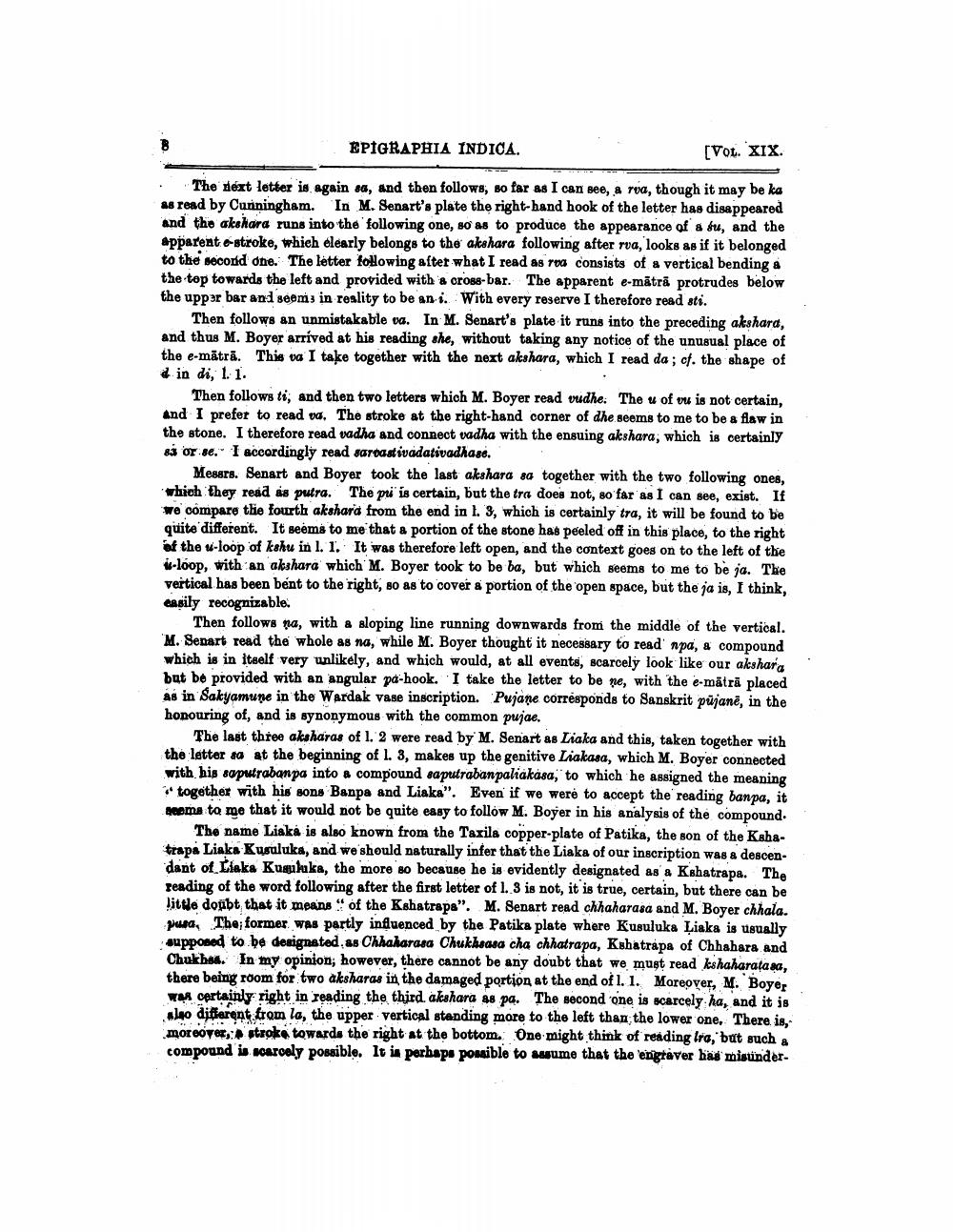________________
EPIGRAPHIA INDICA.
[VOL. XIX.
· The riext letter is again sa, and then follows, so far as I can see, a rua, though it may be ka as read by Cunningham. In M. Senart's plate the right-hand hook of the letter has disappeared and the akshara runs into the following one, so as to produce the appearance of a fu, and the apparente-stroke, which olearly belongs to the akshara following after rva, looks as if it belonged to the second one. The letter following after what I read as rod consists of a vertical bending a the top towards the left and provided with a cross-bar. The apparent e-mătră protrudes below the uppar bar and seems in reality to be an i. With every reserve I therefore read sti.
Then follows an unmistakable va. In M. Senart's plate it runs into the preceding akshara, and thus M. Boyer arrived at his reading she, without taking any notice of the unusual place of the e-mātrā. This va I take together with the next akshara, which I read da; cf. the shape of din di, 1.1.
Then follows ti, and then two letters which M. Boyer read vudhe. The u of vu is not certain, and I prefer to read us. The stroke at the right-hand corner of dhe seems to me to be a flaw in the stone. I therefore read vadha and connect vadha with the ensuing akshara, which is certainly 88 or se. I accordingly read sorodstivadativadhase.
Messrs. Senart and Boyer took the last akshara sa together with the two following ones, 'which they read as putra. The pri is certain, but the tra does not, so far as I can see, exist. If we compare the fourth akshara from the end in l. 3, which is certainly tra, it will be found to be quite different. It seems to me that a portion of the stone has peeled off in this place, to the right at the w-loop of kshu in l. 1. It was therefore left open, and the context goes on to the left of the
-loop, with an akshara which M. Boyer took to be ba, but which seems to me to be ja. The vertical has been bent to the right, so as to cover a portion of the open space, but the ja is, I think, Gasily recognizable.
Then follows na, with a sloping line running downwards from the middle of the vertical. M. Senart read the whole as na, while M. Boyer thought it necessary to read' npa, a compound which is in itself very unlikely, and which would, at all events, scarcely look like our akshara but be provided with an angular pa-hook. I take the letter to be ne, with the e-mātrā placed as in Sakyamune in the Wardak vase inscription. Pujane corresponds to Sanskrit pūjanē, in the honouring of, and is synonymous with the common pujae.
The last three akaharas of 1. 2 were read by M. Senart as Liaka and this, taken together with the letter sa at the beginning of l. 3, makes up the genitive Liakasa, which M. Boyer connected with his saputrabanpa into a compound saputrabanpaliakasa, to which he assigned the meaning
together with his sons Banpa and Liaka". Even if we were to accept the reading banpa, it sepma to me that it would not be quite easy to follow M. Boyer in his analysis of the compound.
The name Liska is also known from the Taxila copper-plate of Patika, the son of the Kshatrapa Liaka Kusaluks, and we should naturally infer that the Liaka of our inscription was a descendant of Liaka Kuulaka, the more so because he is evidently designated as a Kshatrapa. The reading of the word following after the first letter of 1. 3 is not, it is true, certain, but there can be lithe doubt that it means of the Kshatrapa". M. Senart read chhaharasa and M. Boyer chhala. pund, The; former. Was partly influenced by the Patika plate where Kusuluka Liaka is usually supposed to be designated as Chhaharasa Chukhsasa cha chhatrapa, Kshatrapa of Chhahara and Chukbos. In my opinion, however, there cannot be any doubt that we must read kshaharata sa, there being room for two aksharas in the damaged portion at the end of l. 1. Moreover, M. Boyer WAA certainly right in reading the third, akshara 48 pa. The second one is scarcely ha, and it is alto different from la, the upper vertical standing more to the left than the lower one. There is, moreover, stroke towards the right at the bottom. One might think of reading Iro, but such a compound is rarosly possible. It is perhaps possible to assume that the lengtáver has mistinder




